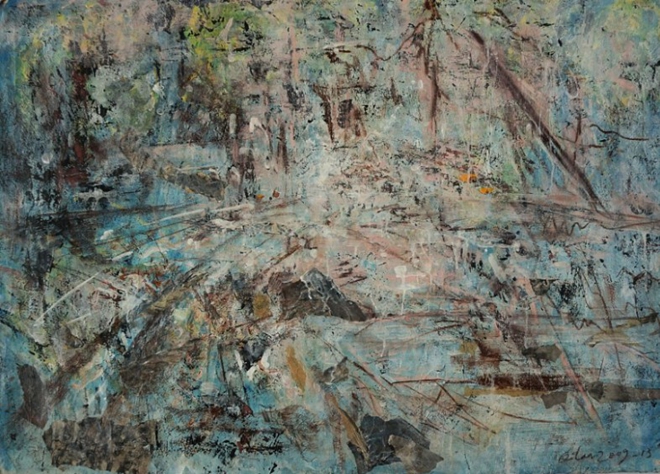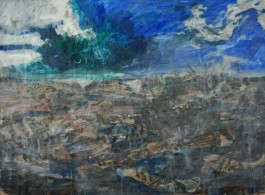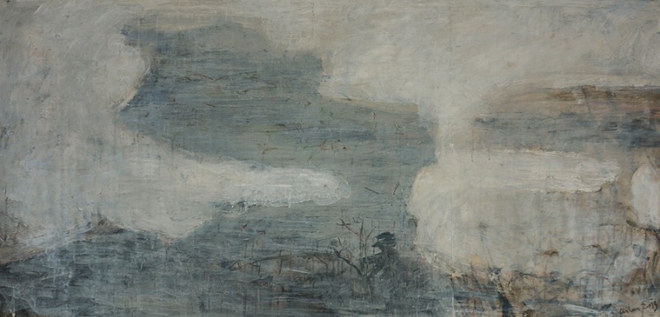[Press Release]
Qi Lan was born in Anyue County, Sichuan Province in 1973. In 1996, he graduated with a Bachelor’s Degree in the major of Chinese Traditional Painting from the Academy of Fine Arts at Southwest Normal University. In 2001, he graduated from the Department of Chinese Traditional Painting at Nanjing Arts Institute, with a Master of Arts Degree. In 2007, he began to study with Professor Wang Mengqi as a Ph.D. candidate in Fine Arts. Currently he is living and working in Shanghai as an editor of Art China.

Buddy’s Fontainebleau, Mixed Media on Paper, 78×107.5cm, 2009-2013
兄弟的枫丹白露,纸本综合材料,78×107.5cm,2009-2013
Qi Lan has gone through the cyclic identity changes from an artist to a journalist, to a critic, and then back to an artist again. Many of his works are related to his readings. Through fragmented and selected readings, he draws inspirations in communicating and even arguing with the classical cases and works in art history. Although having received a long-term regular training in Chinese traditional painting, Qi Lan consciously keeps a distance from traditional painting in his creation, and even despises the mild traditional aesthetics and the introverted cultural character. He argues that, for a contemporary artist, a fresh aesthetic temperament and character are even more significant than the artistic language and form—“one must stand off, get weaned, find something in the wild, and start anew.” “Adventure”, as he perceives, is “the first true meaning” of culture and art, and he believes that “only when a person’s thinking and practice point to the unknown, can the unknown go toward him and unveil the totally unfamiliar and new visual experience before him, which gives him the reason to move forward.”
As a person born in the 1970s and a scholar, Qi Lan has penetrating insights into the modern and contemporary society and its culture. Fostered in the remaining climate of local gentries, he has been enlightened to take the classical approach to knowledge instead of the programmed post-modern approach. In Qi Lan’s understanding, the artist’s characters which are expressed in the art works are of great importance. Even though he sometimes works as an art critic, he never dwells on the so-called necessary logic of artistic history. He maintains that artists should ignore and even transcend the theoretical network. Hence, he is an absolute artist rather than a critic and scholar. Qi Lan’s works reflect the duality and conflict in his disposition. He was once a pure traditionalist—for more than ten years he has been immersed in the genteel Chinese literati tradition and accompanied by Ni Yunlin, Xu Wei, Dong Qichang and Ba Da Shan Ren. But Qi Lan is a contradiction with deep-concealing wild temperament, and he is never an easily tamed person by nature. Exposed to the contemporary cultural context of sudden transformations and disintegrations, he fights against and contradicts himself. His pure artistic pursuit and strong self-consciousness intensifies his denials to the extent that he would rather be squeezed to the margin and bear the dual pressure from history and reality. The early traditional Chinese paintings by Qi Lan resemble the brushstroke of Ba Da Shan Ren and Shi Tao. Whereas his oil paintings feed more or less on the techniques of modern artists, such as that of Giacometti, which places deconstruction over construction in dealing with images. What he depicts most is the pastoral landscape in traditional Chinese paintings. Therefore the juxtaposition of modern techniques and classical objects brings about the tension between deconstruction and anti-deconstruction. It has explicitly unveiled Qi Lan’s attempt for a new possibility in the collision between form and content. However, because of the ambiguous essence of his subjects and his unrealistic tendency in regard to his creation purpose, his art works refuse any textual interpretation, and fend off the logical rhetoric by creating ambiguities, seeking great spiritual elevation from the blanks of logical cracks. (selected from He Gong’s review article Concerning Qi Lan)




